Jayuya, Puerto Rico
Jayuya (Spanish pronunciation: [xaˈʝuʝa]) is a municipality of Puerto Rico (U.S.) located in the mountainous center region of the island, north of Ponce; east of Utuado; and west of Ciales. Jayuya is spread over 10 wards called barrios, and Jayuya Pueblo[1][2] (the downtown and administrative center of the city). It is the principal city of the Jayuya Micropolitan Statistical Area.
Jayuya Municipio de Jayuya | |
|---|---|
Town and Municipality | |
 Lush vegetation and mountains in Jayuya | |
 Flag  Coat of arms | |
| Nickname(s): La Capital Indigena | |
| Anthem: "Ante nos se yergue" | |
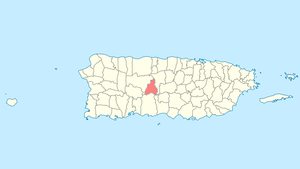 Map of Puerto Rico highlighting Jayuya Municipality | |
| Coordinates: 18°13′07″N 66°35′30″W | |
| Commonwealth | |
| Founded | 1911 |
| Wards | |
| Government | |
| • Mayor | Jorge "Georgie" González Otero (PPD) |
| • Senatorial dist. | 5 - Ponce |
| Area | |
| • Total | 39.4 sq mi (102.1 km2) |
| Population (2010) | |
| • Total | 16,642 |
| • Density | 420/sq mi (160/km2) |
| Time zone | UTC−4 (AST) |
| ZIP Code | 00664 |
| Area code(s) | 787/939 |
| Major routes | |
Named after the Taíno tribal leader, Hayuya, Jayuya is known for its skilled wood carvers. Among its monuments are the statue of Nemesio Canales and the bust of Hayuya, both by the Puerto Rican sculptor Tomás Batista.
History
The town of Jayuya was founded in 1911, but history traces non-indigenous settlers living in the region as far back as 1878. At that time, a small community was established there, separated from the larger cities of the coasts with little to no communication. Near the end of the 19th century, the town focused on the production of coffee, which greatly boosted the local economy.
In 1911, the town was officially declared a municipality with a population of more than 9,000.
In 1950, the town was the setting of the Jayuya Uprising, in which Nationalists started a revolt against the Government of the United States led by Blanca Canales, a social worker, and her cousins, Elio and Doris Torresola. Canales led the group into the town square and gave a speech, declaring Puerto Rico an independent republic. The police station was later attacked, telephone lines cut, and the post office burned to the ground. One police officer was killed and three others wounded in these attacks. The group held the town for three days, until it was bombed by U.S. planes supporting a ground attack by the Puerto Rico National Guard. Even though an extensive part of the town was destroyed, the news of the American bombing was not reported outside of Puerto Rico. Instead, it was reported by the American media stateside as an incident between Puerto Ricans. Most of Jayuya's population is of mestizo descent.
Hurricane Maria
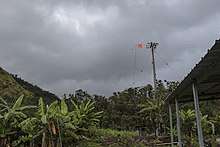
When Hurricane Maria hit Puerto Rico in September 2017, the people of Jayuya had to resort to collecting spring water.[3]
Geography

Jayuya is located in the center of the island of Puerto Rico, in the middle of the Cordillera Central. Due to this location, its terrain is mostly rough and steep. Some of the highest mountains of the island are located in this region, including Monte Jayuya, Cerro Rosa, Tres Picachos and the highest mountain of the island, Cerro Punta, at 4,389 ft (1,338 m).[4]
The town's total area is estimated at 39.4 square miles (102.05 km2). Part of the Toro Negro State Forest is located within the municipality of Jayuya. Rivers like Río Naranjito and Río Yunes, as well as the Río Grande de Jayuya and its various affluents, flow through this municipality.
Barrios
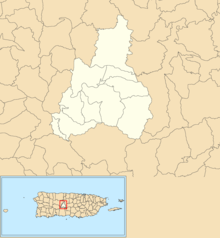
Like all municipalities of Puerto Rico, Jayuya is subdivided into barrios. The municipal buildings, central square and large Catholic church are located in the center of the municipality, in a barrio referred to as "el pueblo".[5][6][7][8]
Sectors

Barrios (which are like minor civil divisions)[9] in turn are further subdivided into smaller local populated place areas/units called sectores (sectors in English). The types of sectores may vary, from normally sector to urbanización to reparto to barriada to residencial, among others.[10][11][12]
Special Communities
Of the 742 places on the list of Comunidades Especiales de Puerto Rico, the following barrios, communities, sectors, or neighborhoods are in Jayuya: Gripiñas, Puerto Plata, Saliente, Salientito, Las Arenas, Comunidad Mario Canals (Sector El Salto), Comunidad Márquez, Hoyo Frío, Sector El Nudo, Santa Clara, Sector San Felipe, and Sector Las Casitas in Vista Alegre.[13][14]
Climate
As in most municipalities located in the mountain region, the climate is mostly cool with temperatures in the 80 to 70 °F (27 to 21 °C) range. However, they are known to go as low as 50 or 60 °F (10 or 16 °C) during some winters.
Demographics
| Historical population | |||
|---|---|---|---|
| Census | Pop. | %± | |
| 1920 | 12,463 | — | |
| 1930 | 12,223 | −1.9% | |
| 1940 | 14,589 | 19.4% | |
| 1950 | 15,113 | 3.6% | |
| 1960 | 14,633 | −3.2% | |
| 1970 | 13,588 | −7.1% | |
| 1980 | 14,722 | 8.3% | |
| 1990 | 15,527 | 5.5% | |
| 2000 | 17,318 | 11.5% | |
| 2010 | 16,642 | −3.9% | |
| U.S. Decennial Census[15] 1920-1930[16] 1930-1950[17] 1960-2000[18] 2010[7] | |||
Culture
Festivals and events
Jayuya celebrates its patron saint festival in September. The Fiestas Patronales Nuestra Señora de la Monserrate is a religious and cultural celebration that generally features parades, games, artisans, amusement rides, regional food, and live entertainment.[4][19]
Other festivals and events celebrated in Jayuya include:
- Three Kings Festival- January
- Jíbaro Tomato Festival- February
- National Indigenous Festival- November
- La Monserrate Marathon- September
Tourism
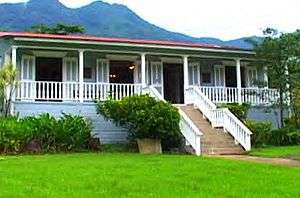
Due to its location, Jayuya is usually mentioned as the obligatory municipality to visit when visiting the center of the island of Puerto Rico. There are several landmarks for tourists to consider like the Nemesio Canales Museum and the Cemí Museum,[20] both located in the same valley.[21] Also, the Taíno Tomb in the city's downtown has the remains of a Taíno Indian found in an excavation. Nearby, there's a monument to Chief Hayuya, cacique of the region.
In the outskirts of the city, tourists can visit the Cerro de Punta, highest peak in the island of Puerto Rico, as well as the other mountains mentioned (Tres Picachos, for example). The Toro Negro State Forest can also be reached through the city.
Jayuya is home to the first aerostat in Puerto Rico and one of the world's largest. It is located in barrio Mameyes, at 3,200 feet above sea level. When the aerostat lifts, it reaches 3,500 feet where it has a panoramic view of 360 degrees.[22]
Coffee production can be seen at Hacienda San Pedro located in Jayuya.[23]
Economy
Agriculture
Jayuya's economy has always depended greatly on agriculture. Products like coffee, tomato, and other vegetables are produced and distributed in the region. Livestock is another part of the city's economy.
Industry
In the middle of the 20th century, several manufacturing industries established in Jayuya, aiming to revitalize the economy as well as provide work for the residents. Some of the companies currently in the city are Baxter Healthcare and Abbott Laboratories. A bridge used by these companies for the delivery of their materials to their plants was destroyed by Hurricane Maria. Work was set to begin on the bridge in 2019.[24]
Government
Like all municipalities in Puerto Rico, Jayuya is administered by a mayor. The current mayor is Jorge González Otero, from the Popular Democratic Party (PPD). González was elected at the 1996 general election.
The city belongs to the Puerto Rico Senatorial district V, which is represented by two Senators. In 2012, Ramón Ruiz and Martín Vargas Morales, from the Popular Democratic Party, were elected as District Senators.[25]
Transportation
There are 34 bridges in Jayuya.[26]
Education
As all other municipalities in the island, Jayuya is part of the Puerto Rico Department of Education. It has several elementary schools distributed throughout the city's wards. However, there's currently only one public high school, Josefina León Zayas High School, located in the city's downtown.
The Metropolitan University, a private institution, has a campus in the municipality's downtown area.
Former mayors
- 1883 Julio Grau Battle - District Commissioner
- 1911-16 Rosario Canales
- 1916-20 Juan de Jesús López
- 1920-24 Ramón B. Marrero
- 1928 José Rivera Aponte (3 months)
- 1928-36 Jesús Dávila Rodríguez
- 1936-40 Vicente Santiago Reyes - Coalition Republican-Socialist
- 1940-44 Juan Oliver Frau PPD
- 1944 Mario Canales Torresola PPD (intern)
- 1944-48 Manuel Diversé PPD
- 1948-52 Ramón de Jesús Soto PPD
- 1952-68 Adrián Torres Torres PPD
- 1968-72 Rafael A. Ríos Delgado PNP
- 1972-76 José D. "Lolo" Castro González PPD
- 1976-84 Antonio Reyes Santiago PNP
- 1984-92 Venancio A. Tejedor León PPD
- 1992-96 José A. Rivera Rodríguez PNP
- 1996 -Jorge L. González Otero(PPD)
Additional information
- July 11, 1883 - The first parish was established
- March 9, 1911 - Municipality was established
- Mayte Vega Torres - National Winner Walker, Athlete
Symbols
Flag
The flag is rectangular in shape and derives its symbolism from the coat of arms. It symbolizes the spirit of people proud of their Taíno heritage and their hospitality.
Coat of arms
Jayuya's coat of arms consists of a shield with a three tower crown above, which is standard for municipalities. Inside the shield, centered at the top, a crown representing Chief Hayuya's monarchy. In the center a green band with a white border representing the Tres Picachos (Three Peaks) mountains. The green color symbolizes the countryside and the town's matron, La Virgen de la Monserrate. At the bottom of the shield, is a petroglyph known as the Taíno Sun found in Jayuya.
Gallery
 Mountain in Jayuya
Mountain in Jayuya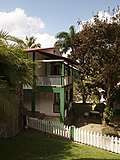 Hacienda Gripiñas in Jayuya
Hacienda Gripiñas in Jayuya
See also
| Wikimedia Commons has media related to Jayuya, Puerto Rico. |
- List of Puerto Ricans
- History of Puerto Rico
- Did you know-Puerto Rico?
References
- Jayuya... El Pueblo de Los Tres Picachos Archived 2012-09-25 at the Wayback Machine - Retrieved 2012-09-24
- Mi pueblo del tomate, Jayuya Archived 2013-07-27 at the Wayback Machine - Retrieved 2012-09-24
- Baez, Alvin (October 18, 2017). "The search for water in Puerto Rico". Reuters. Archived from the original on 15 January 2019. Retrieved 15 January 2019.
- "Jayuya Municipality". enciclopediapr.org. Fundación Puertorriqueña de las Humanidades (FPH). Archived from the original on 2019-08-23. Retrieved 2019-03-20.
- Picó, Rafael; Buitrago de Santiago, Zayda; Berrios, Hector H. Nueva geografía de Puerto Rico: física, económica, y social, por Rafael Picó. Con la colaboración de Zayda Buitrago de Santiago y Héctor H. Berrios. San Juan Editorial Universitaria, Universidad de Puerto Rico,1969. Archived from the original on 2018-12-26. Retrieved 2019-01-04.
- Gwillim Law (20 May 2015). Administrative Subdivisions of Countries: A Comprehensive World Reference, 1900 through 1998. McFarland. p. 300. ISBN 978-1-4766-0447-3. Retrieved 25 December 2018.
- Puerto Rico:2010:population and housing unit counts.pdf (PDF). U.S. Dept. of Commerce Economics and Statistics Administration U.S. Census Bureau. 2010. Archived (PDF) from the original on 2017-02-20. Retrieved 2019-01-04.
- "Map of Jayuya at the Wayback Machine" (PDF). Archived from the original (PDF) on 2018-03-24. Retrieved 2018-12-29.
- "US Census Barrio-Pueblo definition". factfinder.com. US Census. Archived from the original on 13 May 2017. Retrieved 5 January 2019.
- "Agencia: Oficina del Coordinador General para el Financiamiento Socioeconómico y la Autogestión (Proposed 2016 Budget)". Puerto Rico Budgets (in Spanish). Retrieved 28 June 2019.
- Rivera Quintero, Marcia (2014), El vuelo de la esperanza: Proyecto de las Comunidades Especiales Puerto Rico, 1997-2004 (first ed.), San Juan, Puerto Rico Fundación Sila M. Calderón, ISBN 978-0-9820806-1-0
- "Leyes del 2001". Lex Juris Puerto Rico (in Spanish). Retrieved 24 June 2020.
- Rivera Quintero, Marcia (2014), El vuelo de la esperanza: Proyecto de las Comunidades Especiales Puerto Rico, 1997-2004 (1st ed.), San Juan, Puerto Rico Fundación Sila M. Calderón, p. 273, ISBN 978-0-9820806-1-0
- "Comunidades Especiales de Puerto Rico" (in Spanish). 8 August 2011. Archived from the original on 24 June 2019. Retrieved 24 June 2019.
- "U.S. Decennial Census". United States Census Bureau. Archived from the original on February 13, 2020. Retrieved September 21, 2017.
- "Table 3-Population of Municipalities: 1930 1920 and 1910" (PDF). United States Census Bureau. Archived (PDF) from the original on August 17, 2017. Retrieved September 21, 2017.
- "Table 4-Area and Population of Municipalities Urban and Rural: 1930 to 1950" (PDF). United States Census Bureau. Archived (PDF) from the original on August 30, 2015. Retrieved September 21, 2014.
- "Table 2 Population and Housing Units: 1960 to 2000" (PDF). United States Census Bureau. Archived (PDF) from the original on July 24, 2017. Retrieved September 21, 2017.
- "Puerto Rico Festivales, Eventos y Actividades en Puerto Rico". Puerto Rico Hoteles y Paradores (in Spanish). Retrieved 2020-07-17.
- "Cemi Museum". Atlas Obscura. Archived from the original on 10 May 2019. Retrieved 15 June 2019.
- "From The Trenches - Off the Grid - La Piedra Escrita". archive.archaeology.org. Archived from the original on 2019-11-05. Retrieved 2019-11-05.
- "Alcalde de Jayuya dice recuperará inversión del globo a tres años". April 5, 2017. Archived from the original on July 14, 2017. Retrieved July 16, 2017.
- Rivera, Edwin (6 November 2012). "Hacienda San Pedro - Jayuya Puerto Rico". Archived from the original on 8 November 2019. Retrieved 24 June 2019 – via YouTube.
- Irizarry Álvarez, Femmy (January 6, 2019). "Comenzarán trabajos del puente sobre río Viví en Utuado". Primera Hora (in Spanish). Archived from the original on 19 February 2019. Retrieved 7 January 2019.
- Elecciones Generales 2012: Escrutinio General Archived 2013-01-15 at the Wayback Machine on CEEPUR
- "Jayuya Bridges". National Bridge Inventory Data. US Dept. of Transportation. Archived from the original on 21 February 2019. Retrieved 20 February 2019.
External links
Further reading
- Historia, imagen, y sentir de un pueblo: Jayuya - Aura Pierluissi de Rodríguez
- En busca de mis ángeles - Iris de Jesus
- Worker in the Cane - Sidney Mintz
- Tiempos revueltos - Vionette G. Negretti